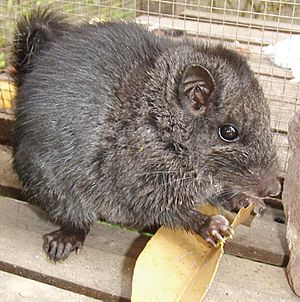Diatomyidae facts for kids
Quick facts for kids DiatomyidaeTemporal range: Early Oligocene - Recent
|
|
|---|---|
 |
|
| A young Laotian rock rat, Laonastes aenigmamus | |
| Scientific classification | |
| Kingdom: | |
| Phylum: | |
| Class: | |
| Order: | |
| Suborder: |
Hystricomorpha
|
| Family: |
Diatomyidae
Mein & Ginsburg, 1997
|
| Genera | |
|
Laonastes |
|
The Diatomyidae are a special group of rodents. They are a "family" in the animal kingdom. This family is part of a larger group called Hystricomorpha. Most rodents in this family are now extinct, meaning they no longer live on Earth.
Today, only one living species from this family is known. It is called the Laotian rock rat (Laonastes aenigmamus). This unique animal lives in Asia.
Contents
What are Diatomyidae?
A Family of Rodents
The Diatomyidae are a family of animals. In biology, a "family" is a way to group living things that are closely related. Think of it like a big family tree. All members of the Diatomyidae family are rodents. Rodents are a type of mammal known for their strong, constantly growing front teeth. These teeth are perfect for gnawing.
Where They Live
Most Diatomyidae species lived long ago. Their fossils have been found in different parts of Asia. Today, the only living member, the Laotian rock rat, is found in Laos. Laos is a country in Southeast Asia.
The Laotian Rock Rat
A Living Fossil
The Laotian rock rat (Laonastes aenigmamus) is very special. For a long time, scientists thought the Diatomyidae family was completely extinct. Then, in 2005, this amazing rodent was discovered in Laos. It was like finding a dinosaur still alive! Because it's the only living member of a group thought to be extinct, it's sometimes called a "living fossil."
Appearance and Habitat
The Laotian rock rat looks a bit like a large rat or a squirrel. It has dark fur and a long, bushy tail. These rodents live in rocky areas. They often hide in cracks and caves among limestone cliffs. This habitat helps them stay safe from predators.
Diet and Behavior
Laotian rock rats are mostly active at night. They eat plants, including leaves, seeds, and grasses. They are shy animals and not much is known about their exact behavior in the wild. Scientists are still studying them to learn more.
History of the Diatomyidae Family
Ancient Rodents
Fossils show that the Diatomyidae family existed a very long time ago. Their history goes back to the Early Oligocene epoch. This was about 34 to 23 million years ago! Many different species of Diatomyidae lived during that time.
Extinct Relatives
Before the discovery of the Laotian rock rat, scientists only knew about this family from fossils. Some of the extinct genera (groups of species) include:
- Diatomys
- Fallomus
- Marymus
- Willmus
These ancient relatives help us understand how the Diatomyidae family changed over millions of years.
Why Are They Important?
The Diatomyidae family, especially the Laotian rock rat, is important for several reasons:
- Understanding Evolution: They help scientists understand how rodents have evolved over millions of years.
- Biodiversity: The discovery of the Laotian rock rat reminds us that there are still many unknown species on Earth. It shows how important it is to protect natural habitats.
- Conservation: The Laotian rock rat is a unique animal. Protecting its home in Laos is important to make sure this "living fossil" continues to survive.
See also
 In Spanish: Diatómidos para niños
In Spanish: Diatómidos para niños

